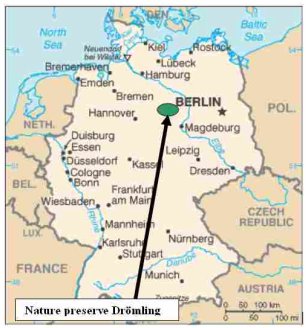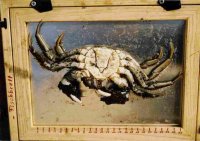 |
Last Update:
Thursday November 22, 2018
|
| [Home] |
Following a request from the IUCN Otter Specialist Group and a lot of information about predation on crabs by different otter species, this paper highlights the importance of incidental observations in solving nutritional puzzles. During a preliminary study at the Midland Canal in January 2007 in the Drömling Nature Reserve (Figure 1, Figure 2) 27 sprainting sites were found along 1 km of the bank with 74 spraints of Eurasian otters (Lutra lutra) containing remains of Chinese mitten crabs (Eriocheir sinensis).
These crabs (Figure 2) were first brought to middle and north European coastal waters in the ballast of international shipping in 1930. Starting from the North Sea, the larvae migrate up the rivers and grow to be adults in about five years. Later, the crabs migrate back into brackish water in order to breed.
The Midland Canal is a European waterway, which connects the rivers Elbe and Weser (Figure 3). Several locks separate the canal from the rivers, difficult for crabs to spread past. Somehow, they found their way into the canal and reached the study area. The Drömling Nature Reserve is a cultivated wetland containing a large number of ditches and a lot of small bodies of water. This area is covered by the Habitats Directive, having European importance for amphibians, migrating birds, Eurasian otters and European Beavers (Castor fiber albicus). It is more than 150km from the coast. In winter 2007/08, an efficiency review of otter conservation measures was carried out on a 30 km length of the Midland Canal in the Drömling Nature Reserve for the “Wasserstrassen – Neubauamt Helmstedt” (Neubauamt Helmstedt Waterways Board).
It is assumed that only one or two individual otters have developed suitable hunting strategy and are able to eat the big crabs (total diameter of approximately 30 cm including legs and pincers, the carapace having a diameter of approximately 8 cm). The crabs show fast reactions and are able to defend themselves with long legs and pincers. During the study, we specifically looked for otter spraints with remains of crabs because in January 2007, 10 spraints containing crab had already been found (Figure 4). Crab remains formed 5% to 70% per spraint in three of those samples, but were as high as 95 -100% in the remaining 7 spraints (within the ten analysed samples).
In winter 2008/09, no further evidence has been found despite the focused search. It is conceivable that the “successful crab hunter” isn’t here anymore, or the population of crabs is fluctuating. In autumn and winter 2005, crabs were founded in high numbers in many ditches and pre-flooders near the Midland Canal, but numbers now seem to be very low. One reason could be the predation on the crabs by carnivores and omnivores like the red fox (Vulpes vulpes), racoon dog (Nyctereutes procyonoides) or wild boar (Sus scrofa). Whether and how these species are able to catch crabs remains unanswered. Anglers are also known to kill the crabs and leave them on land so that otters and other animals could scavenge on them. In general, this phenomenon raises a lot of questions and needs further attention. Résumé : Prédation du Crabe
Invasif Chinois (Eriocheir sinensis) par la Loutre Eurasienne (Lutra
lutra) dans la Reserve Naturelle de Drömling, Saxe-Anhalt, Allemagne Resumen: Predacion de Especies Invasivas de Cangrego Chino de la Manopla (Eriocheir sinensis), por Nutria Eurasiatica (Lutra lutra), en la Reserva Natural de Drömling, Saxony-Anhalt, Germany. |
| [Copyright © 2006 - 2050 IUCN/SSC OSG] | [Home] | [Contact Us] |




